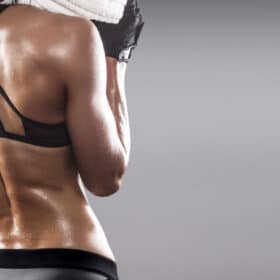Squats are quite rightly the supreme exercise in weight training. The advantages are obvious, because hardly any other exercise activates such a large proportion of the skeletal muscles and can also be used in such a variety of ways. The other side of the coin, however, is the fact that such a complex exercise also has numerous sources of error, which can sometimes have serious consequences. With this in mind, we have set ourselves the goal of presenting you with the 9 most common squat mistakes in the following article so that you can avoid them.
Mistake 1 - You don't go down deep enough
One of the biggest mistakes when doing squats is undoubtedly not bending low enough when performing the exercise. This approach severely limits the potential muscle gains you can achieve during your workout, as the reduction in the range of motion means that many muscle fibers are only recruited suboptimally or not at all and are therefore not stimulated to grow. In addition, the load on your knees is significantly higher due to the deceleration in this position than in the case of the deep squat. Incidentally, these assumptions have been confirmed by studies carried out by Danish scientists, meaning that the myth that deep squats are harmful can be put to bed once and for all. So unless you are already using the maximum range of motion, you should do so in future to achieve maximum results. As it may not be possible to achieve the greatest possible depth of flexion straight away due to a potentially limited hip mobility, it is advisable to improve your hip mobility with stretching exercises or alternative exercises such as goblet squats.
Mistake 2 - Your knees turn inwards
When performing squats, make absolutely sure that your knees remain stable throughout the entire movement and never rotate inwards under the influence of the load. The resulting mechanical load puts unnatural strain on your knees and can lead to considerable damage to the ligaments and joint cartilage in the long term. To prevent this, make sure that your kneecaps are in an imaginary line with the tops of your feet. If your knees still tend to drift inwards, you can strengthen the stabilizing muscles by wrapping an exercise band around your knees to put tension on your muscles, which they need to counteract.
Mistake 3 - You lift your heels off the ground
Another phenomenon that can be observed time and again in gyms is the lifting of the heels, which mainly occurs during the concentric movement phase shortly before the maximum contraction. The underlying problem with this habit is the shift in the center of gravity, as the load moves forward as the heels are lifted. The bottom line is that the load on the heels is much heavier than it should be. To get rid of this habit, it is usually enough to simply concentrate on keeping your heels on the ground during each repetition. However, if this still doesn't work, you can position a 0.25 or 0.5 kilogram weight plate under the balls of your feet so that it is difficult to fall back into old movement patterns in practice. Bear in mind, however, that this approach should only be used with a light to moderate training weight.
Mistake 4 - You only ever rely on one variant
We all know that monotony is the enemy of progress. In light of this fact, it seems all the more surprising that this law, which is carved in stone, does not seem to apply to squatting in particular. As a result, it is not uncommon to see athletes in the gym who only ever perform one variation of the squat over the years. The result is stagnation in terms of performance. If you want to nip this stagnation in the bud, it is essential that you make use of the countless variations in order to constantly confront your muscles with unfamiliar stimuli.
Mistake 5 - You don't use the safeguards
If you are already training in the squat rack, then you should also make use of the safety devices installed there. These bars not only help you to avoid injury if the worst comes to the worst, but also to maximize your performance, as you can push yourself to your limits without a training partner and without having to be afraid. In order for the safety bars to have their optimum effect, they should be set so that they are locked slightly below the height at which the point of maximum flexion is located. This way, you can still free yourself comfortably in an emergency. On the other hand, it is also important to ensure that the bars are not too high, otherwise you will touch them during every single repetition.
Mistake 6 - Not paying attention to the stability of your back
From a health perspective, the most important rule when doing squats is that you should always pay attention to the stability of your back. The lower back is particularly important in this context, as the muscles there absorb a large part of the load and therefore relieve the spine. To ensure this, you should stretch your bottom out slightly during the exercise so that a minimal hollow back is created in the lower back area. Consciously maintain this position, which is also jokingly referred to as 'duck butt' in weight training jargon, to counteract the weight on your shoulders. Don't overdo it at this point, however, because too much curvature, whether concave or convex, is definitely counterproductive for the health of your spine.
Mistake 7 - You don't involve your bottom in the movement sequence
Did you know that the gluteus maximus, i.e. your bottom, is not only the largest but also the strongest muscle in your lower body? So what could be more obvious than to actively and consciously include this muscle in the squat movement, although very few athletes do. This works best if you choose a shoulder-width stance and specifically tense the target muscles over the entire range of motion.
Mistake 8 - You lift your hips too quickly
Another common problem is lifting the hips too quickly during the concentric movement phase, which leads to an uneven straightening of the upper body and overloading the lower back. You can tell whether you are lifting your hips too quickly by the fact that your lower back tires significantly earlier than your thighs during the knee bend. This is due to a lever mechanism that causes you to move the majority of your weight with your lower back. So always try to straighten up evenly.
Mistake 9 - You use the squat pad
Even if your trainer strongly advises you to use the padded squat pad when doing squats, you should simply throw this well-intentioned advice to the wind. Why? Quite simply because the pad prevents you from developing the right feel for the exercise as there is a difference between the bar and the muscles. In addition, the pad also relieves your trapezius muscle so that it cannot adapt optimally to higher loads. So if you train with the pad in the long term, you are scoring a clear own goal and not exactly promoting your image in the gym.








